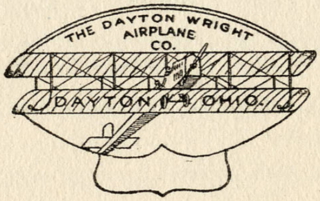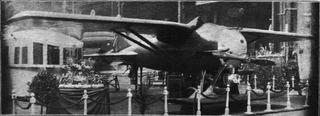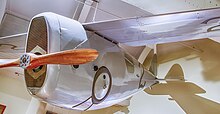
Aermacchi was an Italian aircraft manufacturer. Formerly known as Aeronautica Macchi, the company was founded in 1912 by Giulio Macchi at Varese in north-western Lombardy as Nieuport-Macchi, to build Nieuport monoplanes under licence for the Italian military. With a factory located on the shores of Lake Varese, the firm originally manufactured a series of Nieuport designs, as well as seaplanes.

Nieuport, later Nieuport-Delage, was a French aeroplane company that primarily built racing aircraft before World War I and fighter aircraft during World War I and between the wars.

The Dayton-Wright Company was formed in 1917, on the declaration of war between the United States and Germany, by a group of Ohio investors that included Charles F. Kettering and Edward A. Deeds of Dayton Engineering Laboratories Company (DELCO). Orville Wright lent his name and served as a consultant, but other than that, the location of one of its three factories in the original Wright Company factory buildings in Dayton, Ohio was the only connection to the Wright brothers. In addition to plant 3, Dayton-Wright operated factories in Moraine and Miamisburg, Ohio. During the course of the war, Dayton-Wright produced about 3,000 DH-4s, as well as 400 Standard SJ-1 trainers. The company was hurt by the reputation of the DH-4s it produced as "flaming coffins" or "flying coffins", although they were not in reality more subject to catching fire than other aircraft, and by scandals it faced.

The Dayton-Wright XPS-1 was an American single-seat fighter interceptor aircraft built by the Dayton-Wright Airplane Company.

The Fokker F.XIV was a cargo plane built in the Netherlands in the late 1920s by Fokker. It was a high-wing cantilever monoplane of conventional trimotor layout. The sole example was tested by KLM but never put into service.

The Navy-Wright NW series, also called the Mystery Racer were racing aircraft built by Wright Aeronautical Corporation at the request of the US Navy. Although innovative, both prototype racers were lost before achieving their true potential.

The Nieuport-Delage NiD 42 was a fighter aircraft built in France in the early 1920s, the first in a family of designs that would form the backbone of the French fighter force over the next decade.

The Northrop XFT was an American prototype fighter aircraft of the 1930s. A single engined low-winged monoplane, it was designed and built to meet a United States Navy order for an advanced carrier based fighter. It exhibited poor handling, and was rejected by the Navy, the single prototype being lost in a crash. A variant, the Northrop 3A, also was unsuccessful.

The Verville-Sperry R-3 was a cantilever wing racing monoplane with a streamlined fuselage and the second aircraft with fully retractable landing gear, the first being the Dayton-Wright RB-1. In 1961, the R-3 racer was identified as one of the "Twelve Most Significant Aircraft of all Time" by Popular Mechanics magazine. In 1924, an R-3 won the Pulitzer Trophy in Dayton, OH.

The Miles M.13 Hobby was a small low-winged monoplane built for racing and research in the United Kingdom just before World War II. A single engined single seater, it ended its days in the wind tunnel at the R.A.E.

The Nieuport-Delage Sesquiplans were a series of 1920s French racing monoplanes built by Nieuport-Delage. It was the first aircraft to be recorded as achieving 200 mph (321.88 km/h) in level flight and it established a world air speed record in 1923, attaining an airspeed of 205.2 mph (330.275 km/h).

The Nieuport-Delage NiD 120 series was a series of French single-seat parasol monoplane fighter aircraft of the 1930s. It was built in a number of versions, fitted with various types of engines, with six aircraft designated NiD 123 being sold to Peru.

The Hispano Suiza E-30, later renamed Hispano E-30, was designed in Spain in 1930 as a multi-purpose intermediate trainer. It was a single engine, parasol wing monoplane. About 25 served with the Spanish armed forces until 1945.

The Nieuport Nie 31 or Nieuport 31 was a single-engine, single-seat monoplane or sesquiplane fighter aircraft designed and built in France in 1919.

The Nieuport-Delage NiD 37 was a single-engine, single-seat monoplane fighter aircraft and racer designed and built in France in the early 1920s. It had a small foreplane to bring the centre of pressure forward. Heavy, slower than expected and with turbo-supercharger problems, development ended without any entering service.

The Loire-Nieuport 161 was a single-seat, single-engine, all-metal, low-wing monoplane fighter designed and built in France in 1935 to compete for a government contract. Accidents delayed its development and only three prototypes were completed.

The Hanriot D.I was a French monoplane racing aircraft, designed in France in 1912 and strongly influenced by Nieuport practice. Examples were built and raced both in France and the UK during 1912.

The Kellner-Béchereau 28VD was a French racing aircraft built to compete in the 1933 Coupe Deutsch de la Meurthe. Engine failure and damage sustained in the consequent emergency landing prevented the 28VD from participation in the race.

The Nieuport-Delage NiD 740 was a French trimotor monoplane designed to carry night mail. Two were built in 1930.
The Neiuport-Delage NiD 690 was a French all-metal, single-engined colonial policing aircraft, built for a competitive government contract. Its unusual rear fuselage gave a wide field of downward machine gun fire. Only two examples were built.




















